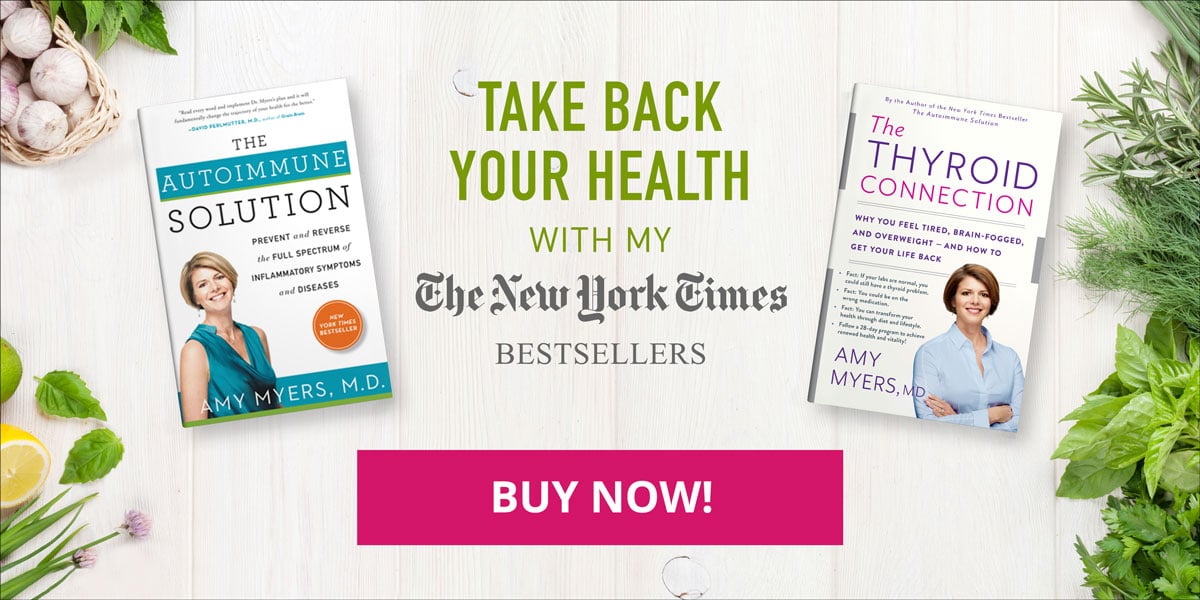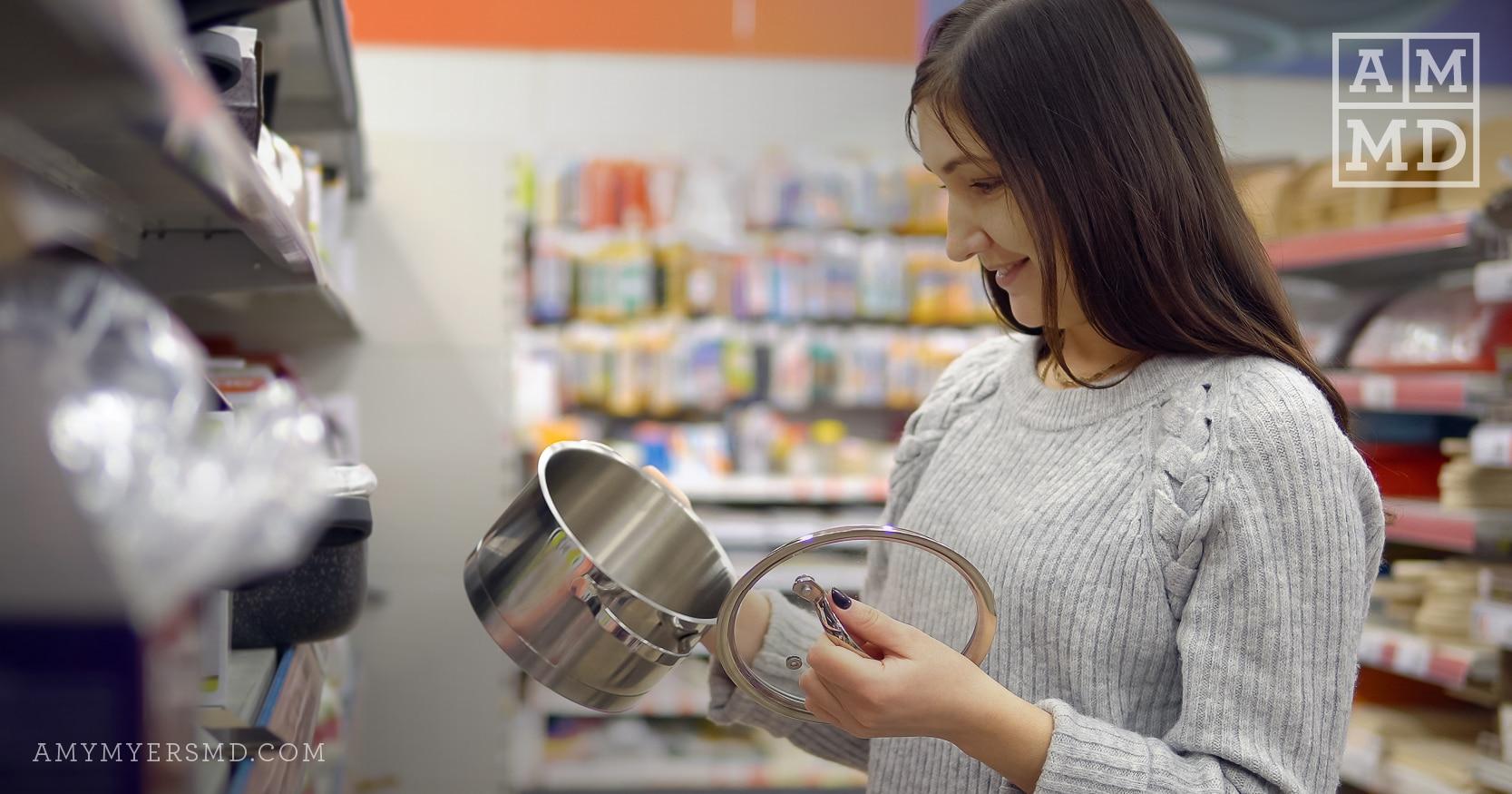When it comes to shopping for your kitchen, sometimes you need an easy-to-use guide to help you find the healthiest cookware and storage options. After receiving a multitude of questions from patients and followers about healthy cookware, I decided to provide you with my personal product recommendations.
While changing out all your cookware won’t happen overnight, switching pots and pans one at a time and making other steps in the right direction can greatly benefit your health. Today, I’ll describe 4 toxic materials to avoid and 4 kitchen materials to gather for a healthier home.
Toxic Cookware to Avoid:
1. Ceramic-coated pans
Ceramic pans and cutlery are usually metals coated with a synthetic polymer that is softer than metal. This coating can easily wear off and can only last for about one year. Once the coating begins to wear off and depending on the material beneath the synthetic polymer, toxic metals can begin leaching into your food.
2. Non-stick cookware (Teflon)
Non-stick cookware contains a similar synthetic coating of polytetrafluoroethylene (PTFE), which is a plastic polymer that can release harmful and carcinogenic gases at temperatures exceeding 500 degrees Fahrenheit. In humans, these fumes can cause flu-like symptoms several hours after exposure, resulting in a condition called polymer fume fever that is often misdiagnosed as the viral flu. The gases are so toxic that for most birds, they are fatal.
3. Aluminum cookware and aluminum foil
Aluminum cookware is often coated to prevent the aluminum from seeping off the appliance. However, these protective coatings easily chip and wear off. Aluminum can be affordable, but may not be worth the risk of transferring aluminum into your food and contributing to potential aluminum toxicity. Aluminum can accumulate in your brain, lungs, bones, and other tissues, causing tangles in nerve fibers and leading to muscular dysfunction and memory loss.1
Aluminum has not been shown to be a cause of Alzheimer’s disease, but increased levels of aluminum in the brain have been noted in autopsies of Alzheimer’s patients which suggests that aluminum toxicity may be a risk factor in the disease.2
Common sources of aluminum include antiperspirants, some toothpaste, aluminum foil, aluminum cans, and aluminum cookware. Simply ditching the aluminum foil for a glass baking dish can help you reduce your intake of aluminum.
4. Copper pans
Copper cookware is popular because it heats evenly over the surface. However, I do not recommend using it in your home. Uncoated copper can leach into your food and even protective coatings will break down over time. Too much copper can suppress your zinc levels and weaken your immune system,3 interfering with adrenal and thyroid function which most commonly results in fatigue.
Use These Non-toxic Cookware Materials Instead:


1. Enameled Cast-Iron
Coated cast-iron pans offer the non-stick benefits of Teflon without the harmful gases. Enameled cast-iron pots are easier to care for and available in various colors, but if you want the benefits of iron, then opt for the bare versions.


2. Bare Cast-Iron
When seasoned properly, bare cast-iron is the ideal non-stick surface. It can also transfer small amounts of iron into your food when cooking acidic ingredients. This can be beneficial for those who suspect an iron deficiency and need to increase their iron intake. Bare cast-iron requires a little more care than enameled cast-iron, but it is more affordable and heats more evenly than its enameled counterpart. Bare cast-iron can also be used in an oven or on a grill.


3. Stainless steel
Stainless steel cookware is affordable and very stable at high temperatures. This cookware is non-stick, lighter than cast-iron, resistant to scratching, and lasts significantly longer than coated materials.


4. Glass
Similar to cast-iron and stainless steel, glass is a sturdy material that will not release chemicals or toxic metals into your food. Glass dishes are ideal for baking and storing leftovers. I recommend using glass storage containers instead of plastic Tupperware in order to avoid toxins like bisphenol-A (BPA),4 which can imitate estrogen and other sex hormones.
Reverse Chronic Illnesses So You Can Take Back Your Health!
Are you ready to beat your symptoms, regain your energy, and feel like yourself again? Whether you have Hashimoto’s, Graves’, or any of the hundreds of other autoimmune diseases, I want you to know you CAN reverse your condition!
Tens of thousands of people around the world have already taken back their health using my New York Times Bestsellers, The Autoimmune Solution and The Thyroid Connection. Are you ready to join them?
In each book you’ll discover how to address the true underlying causes of your symptoms using simple yet proven dietary and lifestyle changes. Best of all, you’ll get step-by-step, four-week plans to put all of the principles into practice and truly make optimal health a way of life!

